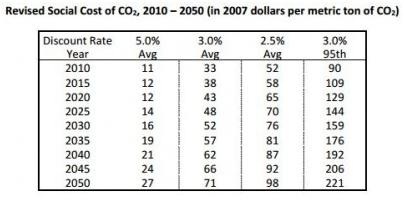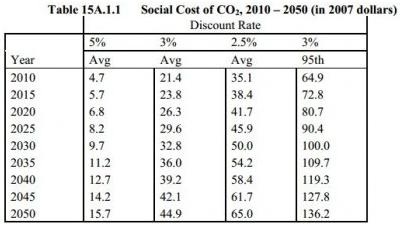A double take on the social cost of carbon
The US government updated its estimate of how much carbon pollution harms the economy. They found that their previous estimated costs were too low – ranging from 50 to 100 per cent depending on the year and the estimate.
An interagency working group coordinated by the White House released something called the ‘Technical Update of the Social Cost of Carbon for Regulatory Impact Analysis’, which is a complicated way of saying that when an agency calculates the economic costs and benefits of a regulation, it now has numbers that reflect more of the true economic impacts of climate change.
This important number has something to do with everything from the proposed Keystone pipeline to what the Obama administration does about climate change to the common microwave.
This year’s Economic Report of the President defined the ‘social cost of carbon’ as a monetised estimate of the damages caused by emitting an additional tonne of carbon dioxide in one year. These damages cover “health, property damage, agricultural impacts, the value of ecosystem services, and other welfare costs of climate change.” Heather Zichal, President Obama’s top climate advisor, explained that these values “draw on the best available science to calculate the benefits of reducing greenhouse gas emissions.”
This calculation follows Executive Order 13563, which directs agencies considering a regulation “to assess both the costs and the benefits of the intended regulation and, recognising that some costs and benefits are difficult to quantify, propose or adopt a regulation only upon a reasoned determination that the benefits of the intended regulation justify its costs.” Because the Executive Order also says “each agency is directed to use the best available techniques to quantify anticipated present and future benefits and costs as accurately as possible,” the government calculated the social cost of carbon.
What kind of numbers are they talking? The update compared the previous estimate with the new one, finding that across most scenarios, the social cost of carbon either doubled or at least increased by 50 per cent:
The SCC estimates using the updated versions of the models are higher than those reported in the 2010 TSD. By way of comparison, the four 2020 SCC estimates reported in the 2010 TSD were $7, $26, $42 and $81 (2007$). The corresponding four updated SCC estimates for 2020 are $12, $43, $65, and $129 (2007$).
The first three numbers are three estimates averaging costs from different scenarios and models, and differ, in order, by how much they discount ‘future costs and benefits’ (5, 3, and 2.5 per cent, respectively). The last number is the cost of emitting one tonne of carbon dioxide under the worst five per cent of all models. These different discount rates essentially reflect how much of the damage an emission today that causes damage to people in the future is actually reflected in the social cost of carbon right now. If discount rates are confusing, read this excellent explanation of what they mean courtesy of David Roberts.
Compare the new numbers:

With last year’s numbers:

What changed? Mostly how much experts think sea level rise will damage the economy. The working group updated a simple climate model to a more complex one. Another model took into account updated sea level rise damage estimates, adaptation assumptions, how temperatures respond to greenhouse gas buildup, and models of indirect methane emissions effects.
Are there other estimates of the social cost of carbon? Absolutely, and most are higher than even the White House’s updated numbers. A report in 2011 by the Economics for Equity and Environment Network found that the White House’s initial calculation was dangerously low. Another study published last year in the Journal of Environmental Studies and Sciences found that the real Social Cost of Carbon was at least between $55 and $266 per tonne. Other reports have estimated something called the ‘Gross External Damages’ of economic activity (coal is the most damaging industry by far).
What’s next, and what does this mean? When agencies rely on the updated numbers to calculate cost-benefit analyses on regulations, those calculations will more completely take into account the true cost of emitting carbon dioxide. The first rule to use these updated numbers is a new efficiency standard for microwaves. With the new numbers, the cost-benefit analysis of the regulation more accurately takes into account how beneficial reducing carbon emissions actually is.
Perhaps most critically, if the White House relies on EPA regulations to carry out its climate mitigation agenda, the updated numbers will strengthen those rules. A regulation that reduces the amount of carbon that coal power plants are allowed to emit will more accurately reflect how beneficial each reduced ton of CO2 actually is.
When the State Department issued its draft Environmental Impact Statement on the Keystone XL pipeline this year, the Environmental Protection Agency recommended the State use a monetised social cost of carbon estimate. If it does this, it will have more complete numbers to use in its analysis, which should make clear that projects like Keystone will emit too much carbon dioxide to allow it to pass a true cost-benefit analysis.
Other regulations, like energy efficiency and clean energy mandates that displace the use of carbon-heavy fuels, are clearly an even better deal when the true social cost of carbon is taken into account.
Conservatives criticise environmental and climate regulations for their effect on economic growth, but these updated numbers help clarify exactly how much carbon pollution harms the economy.
This article was originally published by Climate Progress. Republished with permission.













